An In-Depth Look At Vertical Option Spreads, Part I
Some options strategies may be ideally suited for the potentially volatile markets ahead. We feel that this lesson on vertical spreading by Tony Saliba may be of help to you. Also, for more information on possible options plays, see Tony’s An In-Depth Look At Vertical Option Spreads, Part II and Introduction To Options Spreading. In my last lesson, I introduced the concept of spreading, the trading strategy par excellence (in my opinion) for options practitioners. I began by considering the Vertical Spread, which always consists of one long option and one short option, where both options are of the same type (both calls or both puts), and have the same expiration, but differ in their exercise or strike prices. These spreads are used by traders who already have a view as to the direction of the market: Consequently, we see that vertical spreads are of two varieties, the Bull Spread and the Bear Spread.
In the next two lessons, I hope to examine vertical spreading in much greater detail. Together, we will investigate the composition, risk-and-reward profiles, and the breakeven points for the Bull Call Spread, the Bull Put Spread, the Bear Call Spread, and the Bear Put Spread. By the end of the next two lessons, and with a little amount of work, you will have begun to build a solid foundation as a sophisticated “Spreader”.
I. Some Prefatory Remarks
Before we begin our discussion of Vertical Spreads proper, I think it wise to make sure we are all on the same page concerning some basic terminology and concepts. In this brief Prefatory section, I want to: a) distinguish Credit from Debit spreads, b) note the criterion for distinguishing a spread’s “bullishness” or “bearishness”, and c) examine the risk/reward profiles of the underlying and a naked call, so as to compare it with that of these spreads.
-
Breakeven: Since I paid 5 bucks for it, I would break even on the April 40 call if ABC stock was trading at $45. Why? Because I have to recoup my $5 payment for premium! $40 + $5= $45.
-
Profit: I would make money on the April 40 call for every gain above the Break-even point. Since theoretically, the stock price could go up infinitely, my potential profit is unlimited.
-
Loss: If the option closes below $45, I lose money. The great thing about options, as we all know, is that I don’t have to worry about how far below 45 the stock closes. It’s not a dollar for dollar loss like if I simply owned the stock. The most I can lose is the total premium I paid, here $5. Not a bad deal.
Well, you might say, 5 bucks ($500 per contract purchased) is better than the loss on a straight out purchase of the stock! I’ll just buy the call! But what if you bought 100 calls? Now we’re talking 50,000 bucks! 1,000 calls would be 500,000 bucks! And so on, and so on. Take the case of 100 calls, where you control the equivalent of 10,000 shares of stock. I don’t know about you but I don’t want to gamble on throwing away fifty grand unless I am REALLY sure of what’s going to transpire. Enter the Spread.
II. The Bull Call Spread
The Bull Call Spreader is Bullish in his attitude towards the underlying in question, but perhaps not so bullish as to merely buy the underlying or naked calls. He wants to gain from the foreseen increase in price of the underlying, but isn’t confident enough to “bet the farm” that the underlying will go up. A hedged position is best for him. So he chooses to put on a Bull Call Spread, enabling him to put on a bullish position with a bit of an insurance policy, if you will, for a lower cost than a naked call and a lot less risk than owning the stock. We shall see why this is so in a moment.
Remember we said that a bull call spread is simply a combination of two options, a long one with a lower strike price and a short one with a higher strike price, where both options are of the same type and expiration but have different strike prices.
Let’s look at an example:
BUY 1 ABC April 40 call @ $5 SELL 1 ABC April 50 call @ $3 Net cost of April ABC Bull Spread $2
OK, so what is the possible risk, reward and breakeven point of this Bull Call Spread and how would the risk and reward profile of an outright call compare? Get out those calculator’s, and lets get to work: a) Loss: Let’s start with the easy part. The most the Bull Call Spreader can lose is $3, (or $300 per spread) ; Why? Because he paid $5 for one April 40 call, incurring a $5 debit; but sold one April 50 call for $3, generating $3 credit, and (worst case scenario) because options are the right but not the obligation to engage in a transaction, the guy can just let them both expire worthless if he so wishes. Doing the math: $5 – $3= $2. That’s a lot better than losing all $5 on the straight call purchase, right?
b) Profit: The big compromise in spreading is that the spreader loses the potential for unlimited gain that he had with the naked long call, or by owning the underlying outright. OK, figuring out the exact profit is best done by memorizing a simple little formula, so here it is. (I told you becoming a successful options trader required hard work and discipline.
The profit is limited to the difference between the strike prices (higher-lower) minus the difference between the premiums (premium 1-premium2) , if and only if the underlying is above the second strike at expiration.
In the above example: (50-40) – (5-3)=(10)-(2) = $8
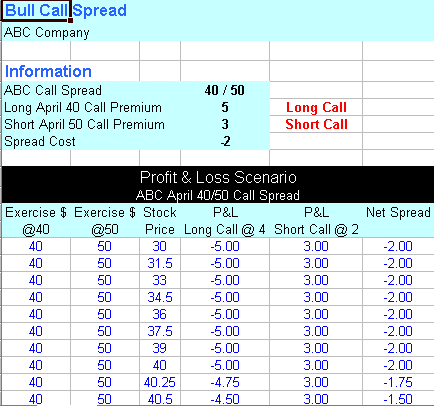
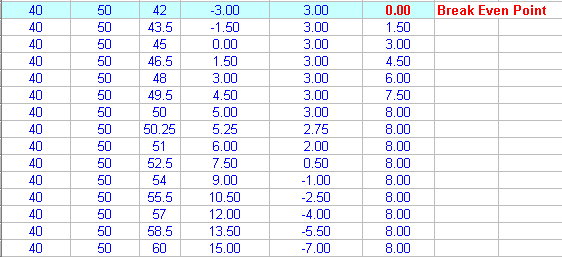
c) Breakeven: Another formula here but much easier:
As we mentioned in our introductory section, spreads can expose the investor to degrees of bullishness and bearishness: for example, if an investor is feeling more bullish, he can enter into a spread that offers a greater possibility of reward on the upside, with the trade off of costing more on the downside. Conversely, a seriously bearish investor can capitalize on a downside move. (Stay tuned for a future lesson!)
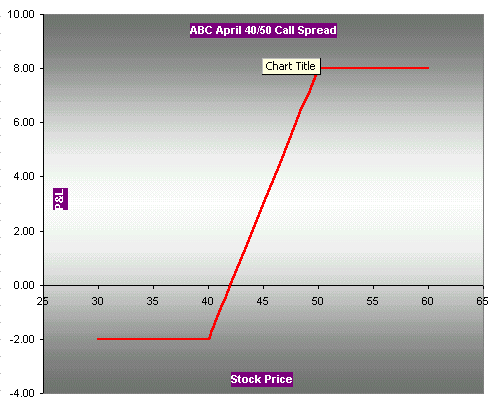
At expiration a Vertical Spread’s minimal value would be zero, if both options expire out-of-the money); and it’s maximum value being the amount between the exercise prices, if both options expire in-the-money.
III. The Bull Put Spread
Now let’s take a look at the Bull Put Spread. In the put market, the Bull Put Spread is the functional equivalent of the Bull Call Spread in the call market: the trader putting on the spread has a bullish view on the direction of the market, and he sells the higher strike put while purchasing the lower strike put. This scenario creates a net credit on the position as a whole because the premium of the short put is greater than the premium of the long put.
This is easy stuff. Let’s look at the maximum profit we can make, the maximum loss, and breakeven point:
a) Profit: SELL 1 XYZ July 55 put @ 6 BUY 1 XYZ July 50 put @ 4
Max Loss: (55-50) – 2= $3
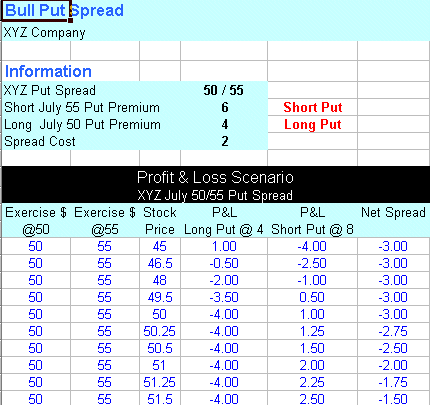
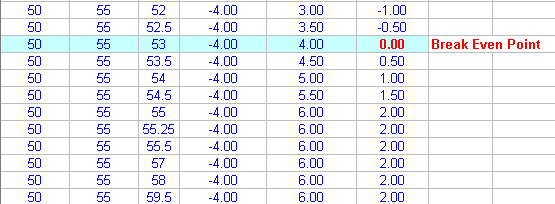
c) Breakeven: Remember, this is a bull spread, albeit composed of puts. Thus we have already seen how to calculate the break-even point. The breakeven point of a Bull Put Spread is always the strike price of the higher option minus the difference in premiums. Here 55 – ( 6-4) 55 – 2 = 53.
So, our breakeven on this vertical is $53 per share on the stock.
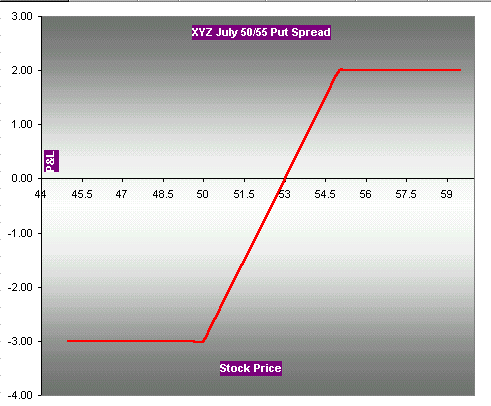
Before we conclude this lesson, we should say a bit about the reasons, or motivations, an options trader might have for selecting one of the above spreads over the other one. So why would I select a Bull Call Spread over a Bull Put Spread, or vice versa? Well, I ask you, start thinking like a trader.
One reason would be that one is a credit spread ( I will take some money in), whereas the other is a debit spread ( I have to pay money out). Another reason might be that there is more risk of early exercise with puts.
These are just a few reasons: I want you to come up with some more on your own! Feel free to write me with what you come up with. Always remember that the successful trader is the one who learns to think for himself under pressure! That’s all for now.
